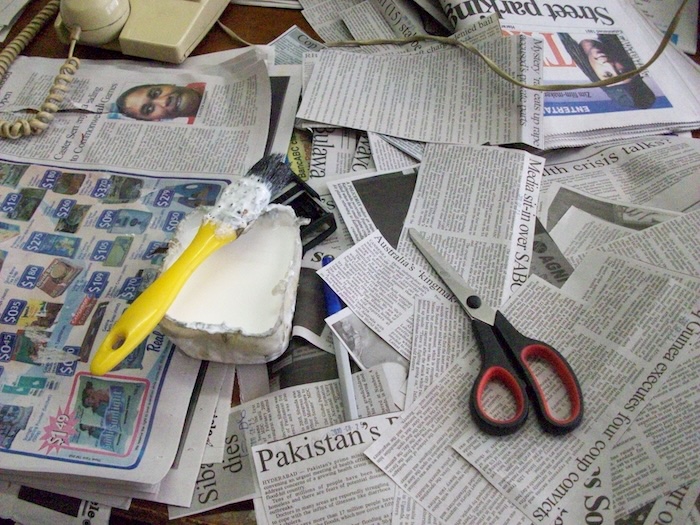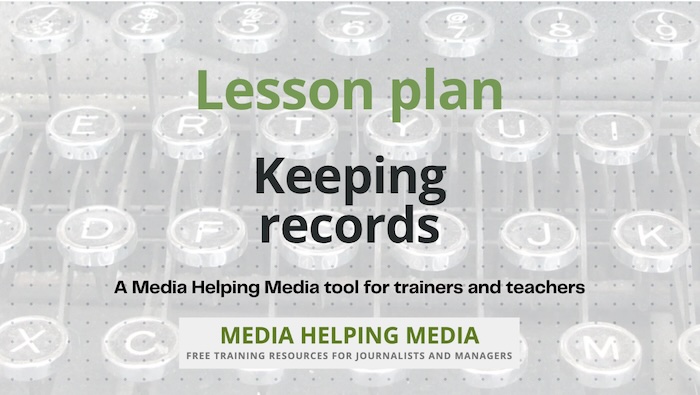
Journalists who want to inform the audience need to keep records so that they can add context to breaking news stories without having to rely on others for background information.
In the past these records were in the form of newspaper cuttings and notes. Now, in the digital age, tools exist to make the task easier. But the basic principles of keeping records has not changed.
Keeping records has always been an integral part of our newsgathering. Technological advances have merely simplified the task of finding, storing, enhancing, publishing, and sharing valuable news assets.
Before computers
When I started as a newspaper journalist, in the days before the internet, I was always looking for information that might prove to be useful in the future.
I had folders of news cuttings which were stored in boxes in my flat. The boxes were filled with articles which I had come across while reading other newspapers and magazines.
I also kept notes, scribbled down while I’d been listening to radio and watching TV bulletins.
Each item was a reminder of something I had found interesting, and which I felt might come in useful in the future.
I had my stack of my reporter notebooks with every fact, note, interview and observation safely stored.
There were carbon copies of every typed story I had written for the newspaper. They were bound in elastic bands and dated.
Keeping copies and records was a newspaper house rule which was put in place for legal and follow-up reasons.
I also had stacks of scrapbooks containing newspaper cuttings of my own work. That was my version of the modern-day online archive; my related stories, if you like.
My newspaper had its own ‘diary-and-file’ cabinet. An office junior would spend all day cutting up articles and filing them away for future use. Each would be labelled and indexed.
If an article covered more than one issue, another copy of the newspaper would have to be cut up so that the content could be filed in more than one category.
If there were important articles printed back-to-back, two more newspapers had to be clipped, and so on.
Cutting up newspapers with scissors and then sticking them to paper with glue was time consuming but it was important because the records we were keeping ended up in a reference library of files available for all staff to use.

Knowing what to keep
It’s important to know who is going to benefit from your the material you are gathering. This will help you decide what to save, what to invest time and effort in developing, and how to present the resulting material.
A journalist covering a specialism (also known as a beat or a patch) will probably find it easier to decide what records to collect. A general reporter may find it more difficult.
However, all journalists should have areas they are interested in and all should understand the needs of their audience.
So gathering material based on your interests and the needs of your audience is a good starting point.
Knowing why we keep it
We keep records because it’s part of our job to inform the public debate. To do that we need to add context to the information we produce with sourced, verified and attributed material.
In a breaking news situation we will probably be dealing with the latest facts only.
But as the story develops, or if we are carrying out an in-depth investigation, we will need to dig deep in order to reference material that will enrich our coverage and enhance the understanding of those consuming it. That is why we need to keep records.
The content we keep must have the potential to add value to our work or to help those we are working with better understand an issue.
Ideally we will know something about the topic. We will add information and then share. By doing so, those who had not seen the original item, and who may have not thought about the line you have developed or expanded upon, might benefit.
There may be a sentence buried deep in an article that is particularly relevant to something you are working on. You can then point to that element and share just that point.
Keeping records helps you unearth gems, polish them and display them for all to see
When I started in journalism I was encouraged by my news editor to have my own storage system which started off as the bottom draw in my desk in the newsroom. There cuttings would relate to ongoing stories that would need following up.
Once a story was no longer current I would move the cuttings to the box in my flat.
I would also contribute to the joint record-keeping effort of my newsroom colleagues by suggesting material to be stored in the filing cabinet in the office.
Later, when I moved to the BBC, there was a department called ‘News Information’ which you could ring up to ask for cuttings. The department had staff whose job it was to store copies of every story for future reference.
Now, there are many great tools, most free to use, that offer different storage and collaboration benefits.
When I worked in newspapers, keeping records was a part of everyday life. However, apart from the material we shared in the office filing system, our own systems were very much a personal thing based on the topics were had invested time and effort covering.
Choosing what to keep
You need editorial focus, audience awareness, and time.
When I worked on my first newspaper I wouldn’t clip every article. A clipping had to have value. It had to be about an issue I was investigating, a developing story in which I would invest more time researching, and, more importantly, information that would help me produce better journalism for those who read the newspaper I worked for.
So my early cuttings had a clear editorial and audience focus. I needed to know who my readers were and what issues kept them awake at night worrying.
Working on a small town newspaper in the north of England made that fairly easy; we rubbed shoulders with the people who read our journalism every day, and so we understood the issues that concerned them most.
So my advice is to draw up a list of the the topics that interest you. Set these categories in whatever online storage tools you are using. Don’t take on too much. Start off by selecting only that content you think you are likely to return to, or which you think may be of use to those in your social network.
If you find something of interest, consider sharing it and inviting others to contribute. Many of the online storage sites will enable others to make suggestions about what you have collected.
If others join in, you could end up with a rich repository of the most valuable information on a topic.
However you don’t want to get swamped. It’s no use storing material if you can’t find it when you need it. Tag items carefully so that you can retrieve any information when you need it.
Today, we have the luxury of tools that enable us to grab anything we see online, store it, tag it, add notes to it and file it. It’s the same end result as keeping records in the days before computers, but it’s faster, neater, and more useful.
What we didn’t have in my old newspaper office was the ability to share cuttings in an instant, and, in doing so, invite others to add their perspectives and share it with their friends.
We would have to work on the material, make phone calls, knock on doors, sit on doorsteps and follow people round to get the quotes and angles needed to be able to create a professional piece of journalism.
That could take days. Then the piece would be submitted to the news editor, the sub-editor, and the editor, printed, distributed, and then read.
And, presumably, once our newspaper was out on the street, someone was probably starting the whole cycle again with our material, cutting it up, referring to the pieces, reusing the material, expanding on it, etc – an early form of viral news dissemination.

Questions
- What are the primary reasons journalists keep records?
- How did technological advances change the way journalists keep records?
- Describe the process of record-keeping in a newspaper office before the digital age.
- What role does audience awareness play in a journalist’s decision on what records to keep?
- Explain the importance of having a personal storage system for journalists.
- How should decide what content to keep?
- Discuss the benefits of using online storage tools for record-keeping in journalism.
- What is the risk of not keeping accurate records?
- Evaluate the impact of digital tools on the speed and efficiency of journalistic record-keeping.
- Synthesise the key elements that contribute to effective record-keeping for journalists in the digital age.
Answers
- Journalists keep records to add context to breaking news stories, inform public debate, and enrich coverage with sourced, verified, and attributed material.
- Technological advances have simplified finding, storing, enhancing, publishing, and sharing news assets, making the task of record-keeping easier.
- Before the digital age, record-keeping involved cutting up newspapers, storing articles in files, and maintaining personal notebooks and scrapbooks.
- Audience awareness helps journalists decide what records to keep by focusing on topics that interest their readers and address their concerns.
- A personal storage system allows journalists to organise and access information relevant to ongoing stories and personal interests.
- Journalists should focus on editorial priorities, audience needs, and the potential value of content when deciding what to keep.
- Online storage tools offer benefits like easy access, collaboration, tagging, and sharing, enhancing the efficiency of record-keeping.
- If a journalist fails to keep records they could be lacking essential information needed to add context and meaning to a breaking news story.
- Digital tools have increased the speed and efficiency of record-keeping by allowing instant storage, retrieval, and sharing of information.
- Effective record-keeping involves editorial focus, audience awareness, use of digital tools, and collaboration to create a valuable information repository.
Lesson plan for trainers
If you are a trainer of journalists we have a free lesson plan: ‘Keeping records‘ which you are welcome to download and adapt for your own purposes.









